FCAS STEPPING INTO FUTURE
by Chris Pocock
The full-scale mockup of the pan-European Next Generation Fighter (NGF) outside Hall 2A at the Paris Airshow is the same one unveiled here four years ago. Does that signify a lack of progress? Some would say yes, after all the subsequent controversy about design leadership and who does what. That issue was settled late last year, with Dassault confirmed as design leader rather than Airbus and various other accommodations involving Indra, MTU, Safran, and Thales also agreed.

The NGF is part of a Système de Combat Aérien du Futur (SCAF)—or Future Combat Air System (FCAS) in English. France, Germany, and Spain serve as the partner countries. This FCAS must not be confused with the other FCAS led by the UK and supported by Italy and Japan, of which Tempest is the combat aircraft element. Meanwhile, across the Atlantic, the U.S. works on its own FCAS, the Next-Generation Air Dominance (NGAD) project.
In all three programs, the system concept continues to evolve. But one key element will involve “remote continues on page 21
DEFENSE
Hyper threat
MBDA consortium looking at ways to intercept hypersonic strike weapons | 8 OEMS

Qatar Gulfstream Qatar Airways is ready to take delivery of its first ultra-long-range G700 business jet | 10
AIRLINES
Forecast says...
Airbus and Boeing predict more deliveries by 2042 than last year’s forecast | 16

WORKFORCE
Filling the gap
More women are joining aerospace careers and could help relieve a personnel shortage | 17 airshow repor ts
DAY 4 JUNE 22, 2023 AINONLINE . COM PARIS AIRSHOW NEWS
Learn more at www.supernal.aero
We’re building new roads in the sky.
GET
THE LATEST AIRSHOW NEWS!
DAVID M c INTOSH
The future is our starting point
Every day, we’re working to help move the world forward. Today, and for generations to come. The future of flight starts now.


Embraer opening P2F conversion line in China
by Cathy Buyck
Embraer will open an E-Jet passenger-to-freighter conversion line in China, its first outside of Brazil, in cooperation with Lanzhou Aviation Industry Development Group. A letter of agreement, revealed at the Paris Airshow yesterday, will see Lanzhou Aviation Industry Development Group convert 20 used E190 and E195 passenger jets to freighters during the first phase. The first example will undergo conversion at Embraer’s facility in Sao Jose dos Campos, Brazil. Lanzhou Aviation Industry Development Group

will start the conversions once the E190F and E195F Brazilian aviation safety authorities and China have signed off on the certification.
The Brazilian aircraft manufacturer launched its E-Jet conversion program in March 2022 in response to the explosive growth in e-commerce and to bridge the gap between turboprop and narrowbody freighter capacity. “The opportunity in China had a significant influence during the decision-making process of the launch of our P2F program,” noted Arjan Meijer, president and CEO of Embraer Commercial
Airliner backlogs build back bigger at PAS
Airliner backlogs continue to build back bigger at the Paris Airshow with more sales agreements signed yesterday. While the flow of new deals slowed somewhat from the first two days, the scale of the new business appears on track to meet at least the lower end of UK-consultancy IBA’s projection of between 2,100 and 3,000 aircraft.
Avolon signed an MoU to take 20 Airbus A330s. The leasing group indicated its eagerness to secure early delivery slots for the A330-900 version of the twinjet.
Boeing also got more backing from Air Lease Corp., which announced orders for a pair of 787 Dreamliners.
In the narrowbody sector, India’s Akasa Air ordered four 737 Max 8s, taking its commitment to the type to 76 aircraft. Luxair
confirmed its decision to build its shorthaul fleet around the 737 Max 7, for which it serves as the European launch customer with an order for four units.
Financiers are back at Le Bourget looking to put mergers and acquisition deals together. One of them is Michael Richter, managing director and global head of Lazard’s aerospace and defense investment bank, and he sees this as the right time.
“We’re at the beginning of a strong upcycle and three to five years from now we’ll realize that there have been big increases in profitability as expenses are rationalized,” Richter told AIN, reflecting on the uptick in sales. But that’s not to say he doesn’t see difficulties in the face of factors such as inflation and rising interest rates. C.A.
Embraer and Lanz-hou Aviation officials celebrate a joint initiative announced here at Le Bourget to convert E-Jets from passenger to freighter configuration in China.
Aviation. Embraer forecasts a market demand for 700 E-Jet freighters over the next 20 years, with China accounting for 34 percent of the global total. Currently, 85 E-Jets fly with Tianjin Airlines, Hebei Airlines, Beibu Gulf Airlines, and Colorful Guizhou Airlines in China.
“We believe the ‘China speed’ in aviation logistics will be an important basis for the sustainable and efficient growth of the Chinese economy,” commented Lanzhou Aviation Industry Development Group president Chen Zhiqiang. “By cooperating with industry-leading aircraft manufacturer Embraer and introducing E-Jets freighters to China, we’ll fully leverage our domestic strength and competitive advantages to boost China’s air cargo market growth.”
The opening of new P2F capacity aligns with the OEM’s strategy to expand its companywide services and support business, which in 2022 generated $1.3 billion in revenue, accounting for 28 percent of total revenues. In the first quarter of this year, Embraer’s services and support division accounted for 46 percent of total revenues.
Embraer Services & Support also launched the next generation of its aircraft health analysis and diagnosis (AHEAD) system for commercial and executive aviation on Wednesday. AHEAD measures 12 new reliability trends of aircraft systems for early degradation detection on E2s, predictive capabilities powered with machine learning, and troubleshooting enhancement for flight controls on dispatch. The company will release another update “soon.” More than 1,250 Embraer commercial and executive aircraft use AHEAD worldwide. z
4 Paris Airshow News • June 22, 2023 • ainonline.com
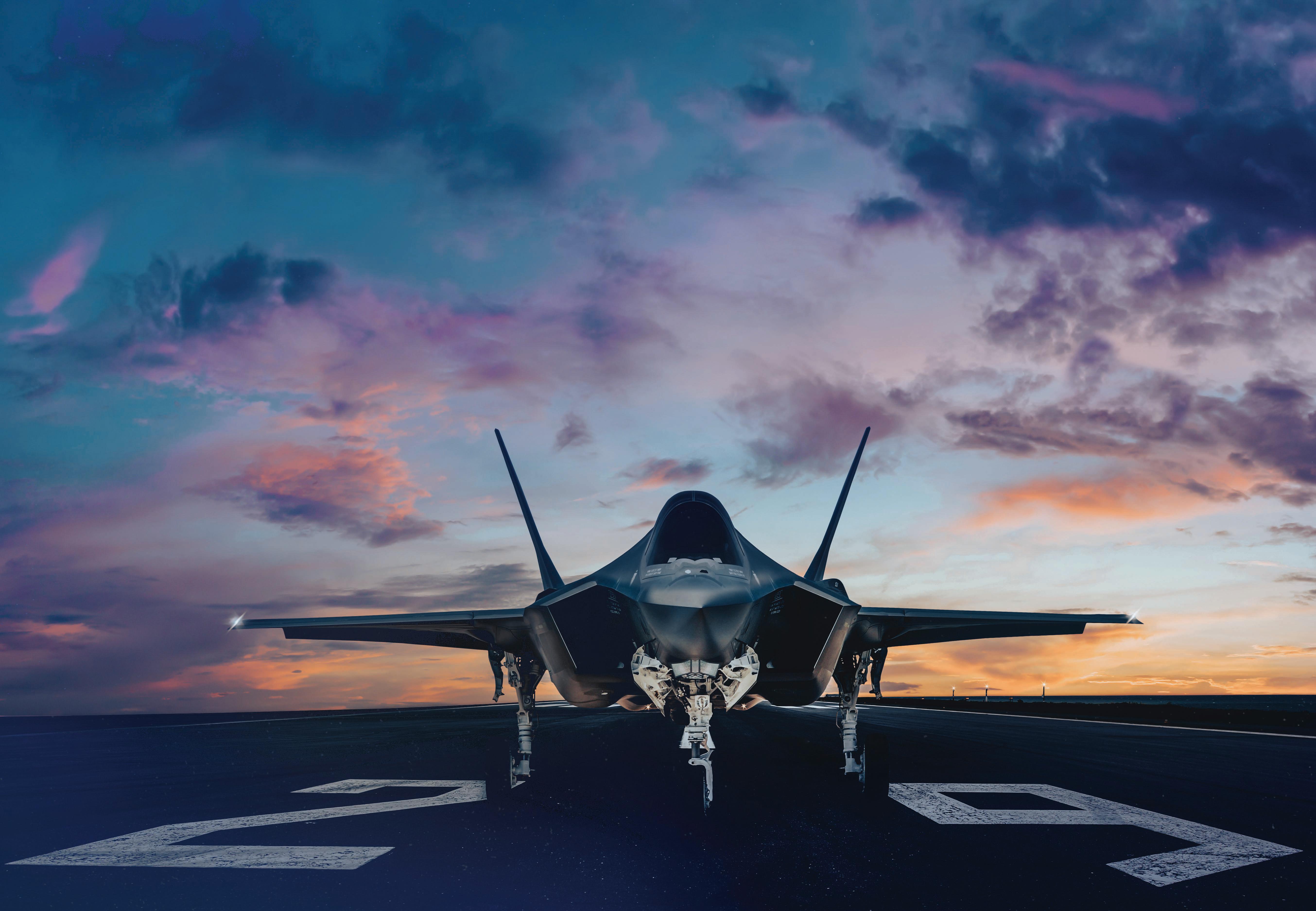
Chief test pilot Steven Schmidt steers the first EMD Red Hawk onto the Lambert Field runway for the type’s first taxi run.
Production Red Hawk preps for first flight
by David Donald
Boeing’s new advanced trainer, the T-7A Red Hawk, cleared a significant hurdle earlier this month by entering taxi trials. Boeing has been flying a pair of production-representative jets for some time and has amassed about 500 flight hours and cleared nearly 8,000 data points with them, but the taxi test marks the first time that the production advanced pilot trainer has moved under its own power. Further taxi trials at increasing speeds followed, signaling that a first flight is imminent, likely in the coming weeks.
The aircraft involved in the trial was APT2, the first of five engineering and manufacturing development machines to be built for the U.S. Air Force. Two Boeing pilots were aboard, including chief T-7 test pilot Steven Schmidt in the front cockpit. The first test successfully validated ground handling functions.
Boeing and the Air Force are now working to resolve issues with the T-7A raised by a U.S. Government Accountability Office report. The principal area of concern involves the pilot extraction system. The T-7 is the first platform for the new-generation Collins Aerospace ACES 5 ejection seat, which the company designed to cater to a wide anthropometric range, covering pilots weighing between 105 and 290 pounds. The wider weight range, especially at the lower
end, has raised some concerns over the severity of pilot/seat separation, but solutions are in progress. Engineers appear to have solved another problem with the explosive canopy-fracturing system, with a successful test having been conducted in February.
Boeing and industrial partner Saab have won a contract to provide 346 T-7As to replace

the elderly Northrop T-38 Talon in the U.S. Air Force’s advanced pilot training program, plus the five EMD aircraft for Air Force tests. The contract includes a comprehensive groundbased training package, with 46 simulators designed with 8k imagery projection for training situations needing high visual definition, such as simulating the transition of aerial engagements from beyond visual range (radar) to within visual range.
The T-7 system, including aircraft and ground training, provides “one push” capability, in which any software upgrades can apply across the whole system. It is fully live-virtual-constructive (LVC) capable, with the ability of the instructor in the aft cockpit to introduce simulated scenarios for the front-seat student in flight. Boeing is working on augmented reality (AR) capability in which, for instance, a simulated air or ground target generated in the system can also be seen “out of the window” on a head-worn AR display.
Boeing acknowledges that the T-7 is generating a lot of interest among international customers and also that the type could be adapted to a number of other roles, such as dedicated adversary aircraft and light attack platform. However, for now, the company is “focused on delivering the advanced trainer to the U.S. Air Force.” z
IAI Elta improves reconnaissance radar
IAI’s Elta introduced an improved version of its ELM-2060P podded synthetic aperture radar (SAR) system, the ELM-2060PES, which produces higher-resolution SAR images over wider areas, with longer ranges.
The system is carried in a pod beneath combat aircraft and is especially useful in conducting reconnaissance at night and in challenging environmental conditions, such as fog, heavy clouds, rain, and smoke. The pod contains the SAR radar with ground-moving target indication (GMTI) capability, which uses a large active electronically-scanned array that peers sideways. Data is transmitted to and from ground exploitation systems by
a bi-directional line-of-sight ELK-1882 H/T datalink with an airborne datalink terminal.
Two SAR modes are available: strip and spot. In the first, the radar builds up wide area coverage using a series of strips. The resolution is fine enough for target detection. In spot SAR mode the radar provides detailed examination of a point of interest.
A typical operational employment would be to use fighters equipped with the ELM2060PES to spot and locate enemy targets such as vehicles under a heavy cloud cover using the strip SAR mode and GMTI. They would then be classified with spot SAR. The radar data relays back to the exploitation center in real-time.
D.D.
6 Paris Airshow News • June 22, 2023 • ainonline.com
Thanks to our experience and R&D network, we are developing innovative technologies for the next generation of propulsion systems to support commercial and military aviation.

We are the European partner of choice for military and commercial propulsion.


We are helping shape a more sustainable future of flight.
Tackling the hypersonic missile threat to Europe
 by David Donald
by David Donald
A European consortium led by MBDA received a tender invitation in May for a European Defence Fund program to examine an interceptor system that can defend against advanced maneuvering hypersonic strike weapons. Known as Hydis2 (hypersonic defense interceptor study), the project has a three-year concept phase, during which three concept architectures—two with three motor stages and one with two—are being evaluated prior to the selection of one for further maturation.
Along with MBDA’s involvement through activities in France, Germany, Italy, and Spain, the consortium covers 19 partners in 14 European nations, including the Netherlands. MBDA has worked on counter-hypersonic defense technology for several years with its Aquila project and already has amassed considerable knowledge of the threat nature and the issues involved in intercepting vehicles traveling at speeds of Mach 5 or greater.
Some of that knowledge has come from recent experiences in Ukraine, where Russian forces have fired hypersonic air-launched Kinzhal missiles and Iskander ballistic/ maneuvering missiles. However, they represent a fairly primitive form of hypersonic threat because their primarily ballistic trajectories are relatively predictable until the
terminal phase. The same holds partially true of the Chinese DF-21 and DF-26 missiles, which employ maneuvering re-entry vehicles (MaRVs) but with still limited degrees of maneuverability following a ballistic approach.
The principal future threat—and the greatest technological challenge—comes from hypersonic glide vehicles, represented today by the Chinese DF-17 and hypersonic cruise missiles such as Russia’s Zircon. They typically fly in the 30,000- to 50,000-foot altitude space, exploiting the gap between the current endo-atmospheric defensive systems—Standard Missile (SM)-2 and -6 and PAC-3—and the high endo-/exo-atmospheric defenses—SM-3 and THAAD.
Moreover, the weapons feature significant freedom of movement, making trajectory predictions almost impossible. Engaging the weapons in the terminal phase close to the target is within the realm of existing systems such as Aster, but that is viewed as a last line of defense and intercepting the weapons while they remain at cruise altitude is considered far more desirable.
However, the highly maneuverable nature of the weapons and their speed makes it almost impossible to maintain an area defense without firing numerous interceptors at one incoming missile to cover all of its possible target approach routes. That can result in the saturation and rapid exhaustion of defenses and would prove costly.
UrbanV, Lilium to develop Italy vertiports
Vertiport developer UrbanV will work with Lilium to establish ground infrastructure for eVTOL aircraft operations in Italy and the south of France. The companies announced their partnership on Wednesday, saying the collaboration could potentially expand to other markets for the six-passenger Lilium aircraft.
According to Italy-based UrbanV, the
company already has access to airports in Rome, Venice, Bologna, Nice, Cannes, St Tropez, and other locations along the French Riviera. The new eVTOL aircraft will operate from sites around the same size as current helipads but equipped to recharge the electric vehicles.
“At UrbanV, we aim to improve people’s lives by enabling a fast, e cient, safe, and
Along with examining new methods of providing timely warning and tracking, one of the key technologies under development involves how to avoid those drawbacks by using deep learning and artificial intelligence to optimize the prediction of likely intercept points. That can be enhanced by delaying interceptor launch as long as possible, which, by definition, implies that the interceptor itself also must be of hypersonic design. z
clean alternative to existing transport solutions,” said company chairman Ivan Bassato. “With our vertiport networks, we are building a technology-agnostic platform for operators to provide new and innovative zero-emission transport services.”
With a range of 155 miles, Lilium sees its aircraft supporting new regional air services, rather than the shorter intra-urban trips intended for many eVTOL aircraft. C.A.
8 Paris Airshow News • June 22, 2023 • ainonline.com
DAVID M c INTOSH
MBDA Aquila

RTX SPONSOR CONTENT
Qatar Airways bids welcome to G700
by Kerry Lynch
As Gulfstream Aerospace heads toward certification of the G700 later this year, international launch customer Qatar Airways unveiled its model in the presence of Qatari dignitaries on the opening day of the Paris Airshow. In 2019, Qatar ordered 10 of the ultra-long-range, largecabin aircraft valued at $750 million. Its private jet charter division, Qatar Executive, will operate the aircraft and anticipates receiving its first copy this year.

Qatar Airways CEO Akbar Al Baker led the ceremonial unveiling in the presence of Qatar Minister of Transport Jassim bin Saif bin Ahmed Al Sulaiti, Ambassador of the State of Qatar to France Sheikh Ali bin Jassem Al-Thani, and Hamad International Airport COO Badr Mohammed Al Meer. Gulfstream Aerospace president Mark Burns also joined them.
En route to the show, the aircraft established a new city-pair record, flying from the manufacturer’s facility in Savannah, Georgia, to Paris in 7 hours 19 minutes at Mach 0.90, Gulfstream reported. The G700 is powered by Rolls-Royce Pearl 700 engines and flies to a
7,500-nm range at Mach 0.85 or a 6,400-nm range at Mach 0.90. Gulfstream noted that it also has reached a record Mach 0.89 speed between Savannah and Tokyo using sustainable aviation fuel.
Importantly for Qatar Executive, the aircraft can operate nonstop from Doha to New
Daher exploring hybrid propulsion pathways
France’s Daher Group has launched a partnership with Ascendance Flight Technologies, a Toulouse-based start-up, to drive research into the hybridization of propulsion for Daher aircraft.
“Hybridization is the best way to show that you are going forward,” said Didier Kayat, Daher Group CEO, at a Paris Airshow media briefing on Tuesday.
Ascendance CEO Jean-Christophe Lambert said that the research would likely benefit other OEMs, as Daher has seen its research and development budget quadruple since 2017 and Ascendance has raised €34 million ($37.2 million) in the past two years.
Daher’s TBM pressurized single-engine turboprop family grew with the introduction of the TBM 960 last year, while another aircraft expected to benefit from the hybridization e ort is the Kodiak utility aircraft series. Operators have taken delivery of more than 1,400 TBM and Kodiak aircraft.
“As a major player in general aviation, Daher Group is committed to achieving the goals around decarbonizing aviation by 2050 and taking significant steps towards that goal during this decade,” said Kayat. “The new collaboration illustrates the 360-degree innovation strategy we’re now implementing to make that happen.” P.S.-S.
York in 13.5 hours and from Doha to Seoul, South Korea, in less than eight hours.
“The G700 represents the pinnacle of business jet travel and will provide Qatar Executive customers with an unsurpassed experience,” Al Baker said. “The technological advances, innovation, flight instruments, cabin configurability, and environmental performance make the G700 a genuine game changer and we look forward to introducing the first G700 into Qatar Executive’s fleet in 2023.”
While Burns recently noted that pandemic-related issues, including staffing shortages at the regulatory agency, have caused the certification process to take “much longer than anticipated,” he was encouraged that the aircraft is nearing approval.
Phebe Novakovic, chair of Gulfstream parent General Dynamics, echoed those sentiments late last month to analysts. “The G700 has done beautifully in the certification process. We are now at a point where the certification process is about compliance,” she said. “The technical issues are behind us. That said, we expect to be done with that process at the beginning of September. We do not, however, control certification. So that could come in the third quarter, more likely in the fourth quarter.” z
10 Paris Airshow News • June 22, 2023 • ainonline.com
Gulfstream president Mark Burns (left) joined Qatar Airways CEO Akbar Al Baker in showcasing the air carrier’s G700, which it will add to its fleet later this year.
Engineering
Dowty is a leading supplier of electronically controlled, allcomposite propeller systems to the global turboprop market.
We are committed to pioneering next generation propulsion technologies and partnering with customers to be at the forefront of sustainable aviation.

Our drive for technology innovation, and the backing of our global support network, has kept customers flying for over 85 years - and will continue to do so for decades to come.
Propelling the next generation of flight
tomorrow’s technology, today.
92% asset availability

LEADERS AREN’T BORN. THEY’RE ENGINEERED.
Another reason to say LEAP. By example.
*Compared to 83% for competition, per third-party data.
That means fewer spare aircraft and more flights, which helps profitability climb.
LEAP-powered aircraft are achieving the highest days flown ratio* for their thrust class.
LEAP turns heads in the boardroom.
cfmaeroengines.com
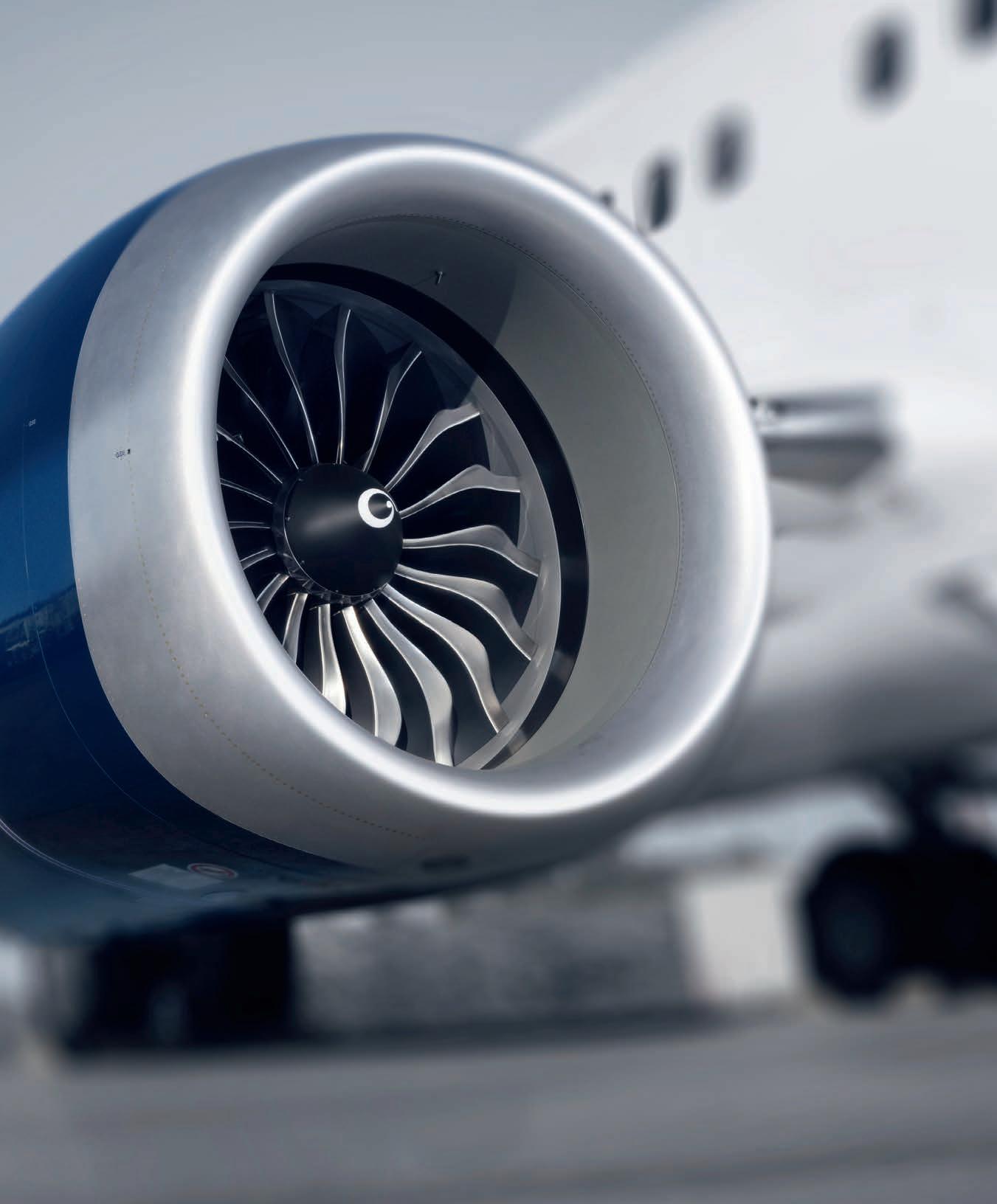
Elettronica morphs into ELT Group
by Cathy Buyck
Elettronica is presenting its new brand and logo as ELT Group at the Paris Airshow. The company adopted its Tenet 2030 long-term business plan in 2021, setting out its ambition to transfer and expand its historic electromagnetic spectrum capabilities from defense to other sectors, including cybersecurity, space, and biodefense.
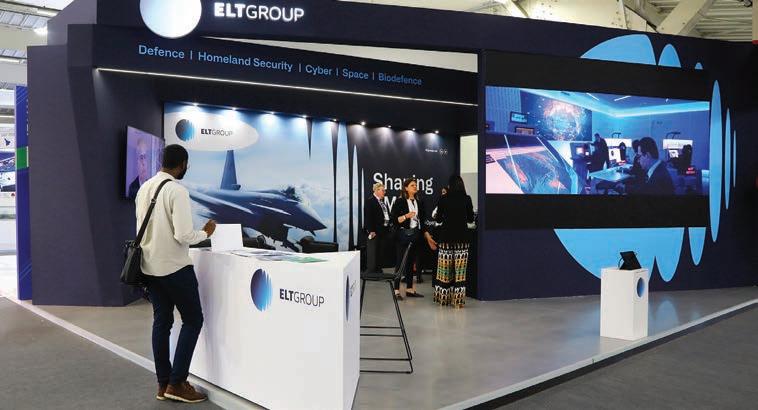
“Following Tenet 2030, ELT Group is evolving to respond more effectively to new technological challenges and increasingly complex protection demands,” said Enzo Benigni, president and CEO of ELT Group. “This evolution has been possible thanks to the deep expertise gained over seven decades in the innovative use of the electromagnetic spectrum through proprietary technologies and through continuous work in research and development.”
In the space domain, ELT group in April
successfully launched its first payload, Scorpio, for space-based signals intelligence collection on board a SpaceX Falcon 9 rocket. Scorpio performs electronic intelligence activities and enables the interception, identification, and localization of terrestrial electromagnetic sources from space, exploiting artificial intelligence algorithms for information processing and classification. The first mission aims to collect unclassified data on maritime traffic.
During the airshow, ELT is highlighting the increased capabilities of its Anti-Drone
Interception, Acquisition and Neutralization (Adrian) system featuring Cyber RF, which makes it capable of effectively detecting and reacting to new and more complex civilian and military operational scenarios involving threats by new-generation malicious drones. Cyber RF complements Adrian’s jamming, radar, and visual modules, further enhancing its performance. According to ELT, Adrian can now perform a full takeover of the drone to achieve a safe landing, avoiding impacts in the location where the drone is flying. z
Collins megawatt generator to help military meet rising power needs
Collins Aerospace is developing a 1-MW electric generator for the U.S. Air Force Research Laboratory (AFRL) as part of its Advanced Turbine Technologies for A ordable Mission-Capability program. The low-spool generator in the works at the Raytheon Technologies subsidiary could apply to a variety of future crewed and uncrewed military aircraft.
The program brief from AFRL would meet the increasing onboard power needs of military aircraft now fitted with sophisticated advanced mission systems, avionics, and high-energy weapons. “While future military aircraft continue to take shape, one thing we know is that these platforms will require electric power in the megawatt range,” said Henry
Brooks, president of power and controls for Collins Aerospace. “To that end, we’re working with the AFRL to design a generator that will give our customers the onboard power they need and the flexibility to tailor its use for multiple potential applications.”
Along with providing onboard power, the new generator could pair with a fuel-burning engine in a hybrid-electric propulsion system. That would maximize the range of aircraft by increasing fuel e ciency while minimizing aerial refueling needs and reducing carbon emissions.
Collins Aerospace aims to deliver the new generator to the AFRL and test it to Technology Readiness Level 5 in 2025. The
company will perform the work at its new The Grid advanced electric power systems lab, due to open later this year.
Collins Aerospace sister company Pratt & Whitney supports the program with a study on future engine integration opportunities. That collaboration builds on the megawatt-class motors Collins is developing for Raytheon Technologies’ hybrid-electric demonstrator programs, including the regional hybrid-electric flight demonstrator led by Pratt & Whitney Canada and the Switch program, which is backed by the European Union’s Clean Aviation Initiative and involves the application of water-injecting turbofan technologies. C.A.
14 Paris Airshow News • June 22, 2023 • ainonline.com
The former Elettronica is now ELT Group, reflecting the expansion of its electromagnetic spectrum capabilities from the defense industry to sectors such as cybersecurity, space, and biodefense.
DAVID
M c INTOSH
Unison is a leading provider of electrical and mechanical aerospace components and solutions.
As an existing supplier to nearly every engine and airframe program, Unison helps deliver the performance its customers need for the most challenging environments – both in the skies and beyond.

Our customers are reaching new heights. We’re helping them get there.
Airbus, Boeing raise 20-yr forecasts
by Cathy Buyck
Airbus projects that airlines and lessors will take delivery of 40,850 new passenger and freighter aircraft over the next two decades and Boeing expects a global demand for 42,595 new commercial jets by 2042. Even though figures are not fully comparable because Boeing takes into account smaller-sized regional jets than Airbus does, the companies align in the upward trend of their projections. In the 2022 edition of their forecasts, the European airframer predicted a need for 39,500 new aircraft in the 20-year period and Boeing 41,170. Those figures reflect an increase of 1,360 aircraft and 1,125 units, respectively.
While the delivery outlook year-over-year has increased, Airbus noted its projection for the 2042 world in-service fleet is smaller than the fleet size it projected for 2038 in its global market forecast from 2019. “Yet we see now more deliveries,” it said. “This indicates our expectation that the pace of fleet renewal towards the most fuel-efficient aircraft will likely accelerate.” The Toulouse-based company expects that airlines will replace about 17,170 previous-generation aircraft by 2042. Only 25 percent of the current installed in-service fleet consists of the latest-generation
aircraft, it remarked, adding that “the shortterm priority for decarbonizing the sector is to replace the remaining 75 percent previous-generation fleets.” Overall, the global fleet will grow to 46,560 aircraft and single-aisle aircraft (carrying more than 100 passengers) will
P&W signs with Awiros for AI analysis tool
Pratt & Whitney (P&W) launched an artificial intelligence (AI)-based aircraft engine analysis tool for geared turbofan (GTF) and V2500 powerplants on Tuesday at the 2023 Paris Airshow. Dubbed Percept, the new product merges computer vision with a video intelligence operating system developed by Awiros.
Percept’s cloud-based interface allows users to capture images and videos of aircraft engines on their mobile devices and receive real-time parts availability status. “Instead of an inspector having to examine an engine
and check part-by-part, Percept automates this inspection and reduces time taken by nearly 90 percent,” the company said.
“The Percept tool helps reduce time and e ort involved in the pre-and-post lease analysis of aircraft engines,” said O Sung Kwon, v-p of P&W customer support. “We have been working with Awiros...for the past few years to mature this technology; we are excited to be shifting from technology development to now bringing an operational product to the market.” C.T.
account for over 80 percent of deliveries over the next two decades, Airbus said.
Boeing, which released its detailed commercial outlook on Sunday, expects the global fleet to nearly double to 48,600 jets, expanding by 3.5 percent per year, as operators replace “about half” of the global fleet with more fuel-efficient models. It projects that OEMs will deliver some 32,000 new single-aisle aircraft—accounting for more than 75 percent of all new shipments—over the next two decades, about 7,400 widebody jets, and some 1,810 regional aircraft. It forecasts that carriers will require 2,800 dedicated freighters, consisting of more than 900 new widebodies and converted narrowbody and widebody models.
By region, Boeing expects Asia-Pacific markets to account for more than 40 percent of global demand, with half of that total in China. North America and Europe each will account for about 20 percent of global demand. It projects that low-cost carriers will operate more than 40 percent of the single-aisle fleet in 2042, up from 10 percent 20 years ago. z

16 Paris Airshow News • June 22, 2023 • ainonline.com
DAVID M c
INTOSH
Airbus and Boeing forecast more aircraft deliveries for the coming two decades than they projected last year, largely driven by demand for fleet renewal with more fuel-efficient models.
Given chance, women could fill aero skills gap
by Charles Alcock
The aerospace and defense industries suffer from a widely acknowledged skills deficit due to the struggle to recruit and retain talent. This is all the more reason, over and above social equity considerations, to make it clear that the door is wide open to women.
Tomorrow is International Women in Engineering Day, giving pause to the aviation sector to consider whether it is on the right path. AIN surveyed 20 of the industry’s leading companies and the overriding conclusion was that progress has been made, but there is some way to go. Just under one-fifth of engineering positions are filled by women at a time when the gender ratio for the overall workforce is generally closer to a quarter.
That said, recent years have seen some high-profile examples of women breaking through the so-called “glass ceiling” to senior engineering leadership positions. For example, in 2021 Sabine Klauke succeeded another woman, Grazia Vittadini, as chief technology officer of Airbus. Vittadini subsequently joined engine maker Rolls-Royce as its CTO.
And there may be more to come. Also at Rolls-Royce, Sophie Chittim is the lead research and technology engineer working on the UK engine maker’s fuel cells and electric propulsion systems.
According to Boeing’s 2023 Global Equity, Diversity, and Inclusion Report, women accounted for 17.4 percent of the company’s engineering cohort, representing an increase since 2020 from 16.5 percent. Women’s representation in the overall workforce increased from 23.2 percent in 2020 to 24.1 percent in 2022. Over the same period, the proportion of women in management roles crept up by 1.4 percent and by 2.8 percent for production and maintenance roles.
In the report, Boeing said it is boosting investments in early science, technology, engineering, and math (STEM) education. In
2022, around 2.2 million young women and girls participated in STEM education.
Just over a quarter of Raytheon Technologies’ 182,000-strong global workforce are women, and 32.7 percent of that group are executives, with 30.8 percent of those serving at the board level. Those percentages have gradually edged up in recent years.
In 2020, the U.S.-based group reported that 17.8 percent of its approximately 55,000 engineers were women. Last year, women and/or people of color accounted for 45.4 percent of all new employees.
a career break for reasons such as childcare. It also has invested more than $1.5 billion in its employee scholarship program and backs initiatives to boost learning in STEM subjects.
At Lockheed Martin, the overall representation of women in the workforce has inched up in recent years to 23.3 percent. It runs business resource groups and inclusion councils as platforms to support efforts to encourage diversity and opportunity for career advancement. It also is involved in programs such as Girls Inc., and Million Girls Moonshot.
As of last year, women accounted for 23 percent of all BAE Systems employees and the company told AIN it has set a target to increase that to 30 percent by 2030. To achieve the objective, the UK-based company is prioritizing STEM initiatives with, for example, STEM Learning Ambassadors, who currently support about 800 employees and
The aerospace industry needs more women like Sophie Chittim, Rolls-Royce’s lead engineer for fuel cells and energy storage systems, to help fill a skills gap. Currently, only 17.4 percent of aerospace engineers are women, even though they make up half of the overall global population.

For the past two decades, Raytheon businesses have participated in events such as Introduce a Girl to Engineering Day. As part of a broad diversification strategy, it has more recently partnered with the Girls Who Code and Paradigm for Parity organizations, and company representatives sit on the Society of Women Engineers’ Corporate Partnership Council.
Engine maker Pratt & Whitney has become involved in several such initiatives, as well as the Will Rise movement to accelerate the professional advancement of women and the Re-Empower Program. The latter helps people return to the workforce after taking
offer work experience to women in roles that usually have the fewest female applicants. In 2022, the company sponsored 15 women to complete an industry-recognized software engineering qualification for free through a partnership with Code First Girls, fast-tracking all of the participants into its graduate scheme.
BAE has signed onto diversity pledge programs such as Women in Defence Charter and the Bloomberg Gender Equality Index. Last year, women accounted for 30 percent of its apprentice intake and the company won honors as Graduate Employer of Choice as chosen by female engineering job hunters. z
ainonline.com • June 22, 2023 • Paris Airshow News 17
DAVID M c INTOSH
Air France KLM mx unit sees return to 2019 revenue levels next year
Air France Industries KLM Engineering & Maintenance (AFI KLM E&M) expects to return to 2019 revenue levels in 2024, executive vice president Anne Brachet told reporters at a briefing at Paris Airshow Wednesday.
Honeywell inks engine deal for Aeralis trainer
by Chris Pocock
Honeywell Aerospace this week at the 2023 Paris Airshow signed a memorandum of understanding with Aeralis to integrate the OEM’s F124 turbofan into the British company’s new modular aircraft. Aeralis is marketing the airplane as a modern jet trainer and light combat aircraft. It has designed a fully adaptable common core fuselage while using different wings and engines depending on the mission.
Honeywell insists that the F124 also is adaptable. John Guasto, v-p of defense and space, said that the engine delivers “the reliability, thrust, and affordability that competitive offerings simply cannot match.” The F124 already features on the Italian M346 trainer.
In an interview with AIN on Tuesday, Guasto described the company’s ambitions in the defense business for its product line, which includes avionics, wireless connectivity systems, mechanical components, and other products, as well as engines.
Honeywell also responded to the announcement that Collins Aerospace began testing its
Enhanced Power and Cooling System that the Raytheon Technologies company has pitched to displace Honeywell’s incumbent Power and Thermal Management System (PTMS) on the forthcoming Block 4 variant of the Lockheed Martin F-35 fighter.
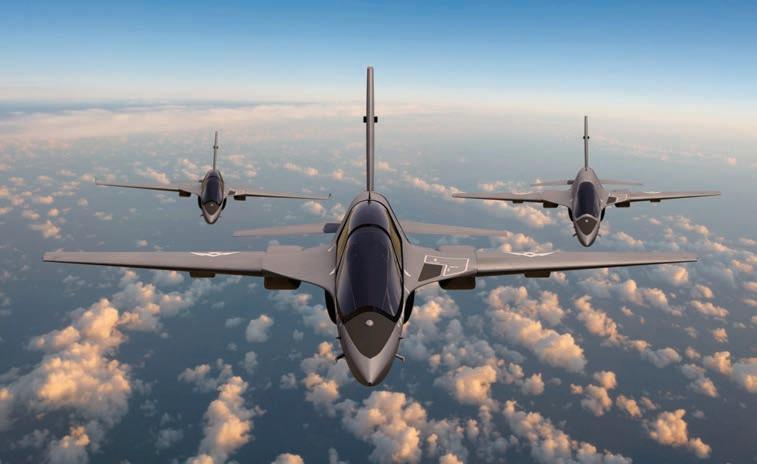
“Honeywell’s PTMS has met all the requirements set forth by Lockheed Martin,” the company said. “Honeywell continues to work with Lockheed Martin and the Joint Program Office to meet anticipated cooling requirements.” The company said it remains under contract with Lockheed Martin to significantly increase the cooling that its PTMS provides.
Guasto said the company’s JetWave MCX satcom system offers high bandwidth and anti-jam capability particularly suitable for UAV data feeds and C2. Honeywell promotes counter-GPS jamming products for various aircraft produced by overseas airframers such as Korea Aerospace Industries and Turkish Aerospace. Honeywell has a facility at Brno in the Czech Republic that has begun producing various non-ITAR systems, including hybrid fuel cells and propulsion for UAVs. z
The company performs MRO work on more than 3,000 aircraft, has over 200 customers worldwide, and saw 500 engine shop visits last year, when it earned total revenues of €3.6 billion ($3.93 billion).
At its 20 maintenance facilities, it conducted over 275 C and D checks last year, more than 40 cabin programs, and operated eight logistics centers. The headcount today totals 12,800 and the company expects to add a further 1,000 sta in the coming three years. O cials said that Air France had added 400 MRO technicians last year and KLM a further 200.
AFI KLM E&M announced deals this week at Paris Airshow involving the A220 fleets of JetBlue and Air Austral, as well as agreements with CMA CGM Air Cargo, Air Senegal, and Philippine Airlines.
Looking ahead to the next decade, Brachet believes engine and line maintenance and components will dominate the market, while minimizing airframe heavy maintenance and modifications where possible amid continuing supply chain issues, an unstable geopolitical situation, and the ongoing specter of inflation. Brachet said that MRO trends followed fleet trends and that the market needed reliable players. “The key message from the market is service level,” she said. P.S.-S.
18 Paris Airshow News • June 22, 2023 • ainonline.com
Aeralis modular trainer
Embraer engineers confront future tech challenges
by Matt Thurber
Having certified more than 20 aircraft since 2000, Embraer’s engineering team is moving ahead with a number of projects, although new clean-sheet aircraft designs don’t top the list for now. The 3,500-strong centralized engineering operation supports all of Embraer’s business units, not just aircraft but also defense and maritime systems, according to Luís Carlos Affonso, senior v-p of engineering and technology.
“This is another part of our secret sauce,” he said. “We learn from one business to another and keep improving. There are so many opportunities to improve the way we develop products.”
Embraer boasts an excellent track record for meeting development budgets, timelines, and specifications, according to Affonso. Embraer completed the E2 jet program two months ahead of schedule, he added, much faster than the Airbus neo, Boeing Max, Bombardier CSeries, Sukhoi Superjet, and the canceled Mitsubishi MRJ. “The E2 was triple-certified [simultaneously] by Brazil’s
ANAC, EASA, and the FAA, the first time in history,” he said.
From the customer perspective, Embraer’s three aircraft manufacturing business units— E-Jet airliners, the KC-390 utility transport, and the Praetor and Phenom business jets— all exceed reliability targets. “We don’t give the airplane to customers to finalize development,” added Affonso.
Current activities in new product development include an E1 freighter, new configurations for the KC-390, supporting Eve’s eVTOL development, and ramping up to fill the recent NetJets order for up to 250 Praetor 500 business jets.
Meanwhile, Embraer is preparing for industry disruption, Affonso explained, especially the goal of net-zero carbon emissions by 2050. “There is a huge challenge in sustainability,” he noted. “We believe the challenge goes beyond commercial aviation. It seems far away but the challenge is huge.”
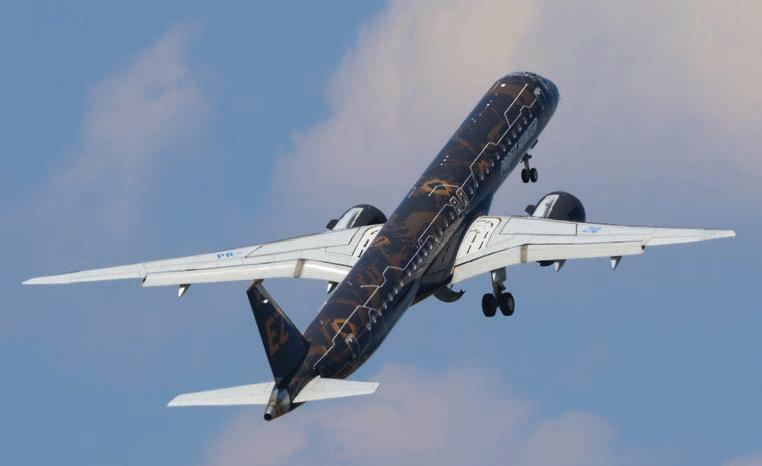
While Embraer spinoff Eve Air Mobility moves ahead with its eVTOL design, which has gained 2,850 orders, Affonso seems well aware of constraints affecting
battery-powered aircraft. “Full electric [works] for small machines, but batteries are not developing as fast as anticipated,” he explained. Embraer is testing 100 percent sustainable aviation fuel (SAF) and high-temperature fuel cells as well as technology that would work with future propulsion systems such as a carbon nanotube deicing system and electromechanical actuators and controllers for electric aircraft.
Affonso sees many opportunities for hybrid-electric aircraft and hydrogen fuel cell powerplants. But for larger aircraft, he said, “We believe SAF is the only solution [to reach carbon reduction goals]. Our mission is to become the leader in the netzero mission.”
Asked whether the aerospace industry is running out of ideas as technological innovations plateau, Affonso responded emphatically that isn’t the case. “It’s quite the opposite,” he inisisted. “The amount of different ideas and possibilities we are analyzing…especially because we don’t know how they will evolve, [our goal] is to try to invest and be up to speed in all those possibilities.”
The various types of energy sources under development bring many opportunities. “Even though the energy may be different, the amount of modification and learning we’ll have to do on the airframe side will be huge,” said Affonso, who named thermal management as one challenge. “Fuel cells generate huge amounts of heat,” he explained. “We have to learn how to deal with this without generating too much drag. There are so many integration issues, it’s not just plug and play what someone else is doing.” z
ainonline.com • June 22, 2023 • Paris Airshow News 19
Embraer’s E195-E2 launches into the Le Bourget skies during the Paris Airshow flight demonstrations.
online AIN logo: C 0 M 100 63 B 12 Hex: D31245 RGB: R 211 G 18 69 Online: 65% black font: Myriad Pro semi extended AINonline logo THERE IS LOTS MORE ONLINE! go to .com for further coverage of the Paris Air Show
DAVID M c INTOSH
French president Emmanuel Macron (right) visits Jérémy Caussade, CEO of Aura Aero (fourth from right) at the Paris Airshow on Monday.

Aura Aero adds hybrid regional airliner orders
by Peter Shaw-Smith
Charter provider Elit’Avia has added eight examples of Aura Aero’s hybrid-electric regional airliner to its existing order for 20, boosting Aura’s order book to more than 330 aircraft secured by letters of intent. The company is developing a series of two-seat training
aircraft as well as the 19-seat ERA airliner at its Toulouse Francazal Airport headquarters.
The growing level of interest helps the French company stand out from the more than 300 developers of future-generation aircraft, according to Aura Aero CEO and chief engineer Jérémy Caussade. “You have a clear distinction between projects and companies,” he told AIN. “We
already have more than 6,000 square meters of municipal facilities, production agreements, and certified environments. For me, [many projects are] a bubble and will remain so.”
“This is in line with our business model and development in reducing our gas emissions and carbon footprint,” said Elit’Avia CEO Michel Coulomb. “This is the direction we have decided to take and that’s why we decided to go with another eight aircraft and 28 in total.” He added that the LOIs would turn into firm orders in the next two to three months.
Caussade said there are three main markets for the ERA. “The first one is the classical commuter model with 19 seats, the island hopper, or for point-to-point mobility,” he told AIN “A second is the cargo version because of the 20-meter cubed cabin size, which is of interest in North America mainly. And then there is executive and business, which is what we’re talking about today.
“It is for us to showcase the capabilities—we offer something that is new. It’s a positive way of saying that there is a match between decarbonization and doing business—because it makes sense. We have to work together to make it happen. This is the next step we are taking right now, and I’m very happy about that.” z
General Atomics Gray Eagle flies with new heavy fuel powerplant
General Atomics Aeronautical Systems, Inc. (GA-ASI) has conducted the first flight of its new heavy-fuel (diesel) engine for the MQ-1C Gray Eagle remotely piloted aircraft. The recently disclosed flight took place at the company’s El Mirage test airfield in California on May 9.
From the start of the MQ-1C program, the U.S. Army specified a heavy-fuel engine so that the fleet could employ the same fuel used in land vehicles. The new powerplant—the 200hp Heavy Fuel Engine (HFE) 2.0—replaces the current 180-hp unit and is a feature of the Gray Eagle 25M now under development. This version is destined for the U.S. Army’s future Multi-Domain Operations, with an open system architecture, new sensor capabilities,
and new communications systems.
GA-ASI began the program in 2016 with the goal of developing a more reliable and durable engine than the Thielert Centurion that powered the initial Gray Eagles. The program also sought to address diminishing manufacturing source issues. Company a liate General Atomics Europe worked with UK
propulsion innovator Cosworth to develop the engine, while GA Electromagnetic Systems designed dual-brushless generators that deliver 50 percent more power for payload operations. The generators contribute to a reduction in field maintenance and a 40 percent extension in time between overhauls compared to the current engine. D.D.

20 Paris Airshow News • June 22, 2023 • ainonline.com
A Gray Eagle lifts off from El Mirage for its first flight with the HFE 2.0 engine.
Safran to open four motor facilities
 by Peter Shaw-Smith
by Peter Shaw-Smith
Safran Electrical & Power plans to install production lines for its EngineUs electric motors at sites in France and the UK. Starting in 2026, a high-volume production model inspired by the automotive sector will enable the manufacture of 1,000 motors a year to serve electric and hybrid aviation markets.
In 2025, Safran will open four lines to automate the production of the motors. Two will be located in Niort, western France, at the group’s electrical systems center of excellence, and two in the UK, at Pitstone, Buckinghamshire, which serves as Safran’s rotating machines center of excellence. The UK site will be home to automatic production lines for rotors and stators—rotating machines at the heart of the motors—while Niort will handle the automatic production of power electronics and final motor assembly, Safran said.
At Niort, France’s DGAC has agreed to provide a 50 percent investment, and machines
Next-gen fighter
continued from page 1
carriers”—small UAVs for electronic warfare, reconnaissance, and ground attack, some of which will be expendable and launched from combat aircraft such as the NGF or Tempest.
At a recent Royal Aeronautical Society conference in London, Major General JeanLuc Moritz, chief of FCAS for the French air force, said that the remote carriers should first integrate with legacy fighters such as the Rafale. He said that 11 “operational vignettes” for FCAS had been projected, covering not only the obvious missions such as offensive counter-air, deep strike, and so on but also short-field operations and how to deploy. The French require the NGF to be carrier-capable because a new warship will be built to replace the Charles De Gaulle
The Airbus-Dassault pact allowed the three
specialist Baron Groupe will develop the automated lines and workstations. In Pitstone, Aerospace Technology Institute has taken a 50 percent stake and Adelphi Group will facilitate line set-up. Two British universities—the University of Warwick and Nottingham Trent University—will also provide expertise to implement co-engineering methods.
“We have chosen to create our future automated electric motor lines in Niort and Pitstone because these facilities are a perfect fit for our industrial plan,” said Bruno Bellanger, executive v-p and general manager of the
power division of Safran Electrical & Power. “This is a significant step toward mass production of our EngineUs electric motors to the highest performance standard. We are on the home stretch in obtaining final certification from the air authorities. This state-of-the-art equipment is one of the essential building blocks in Safran’s decarbonization strategy.”
Safran said five aircraft manufacturers— VoltAero, Aura Aero, Bye Aerospace, Diamond Aircraft, and CAE—had selected EngineUs electric motors to equip their electric or hybrid aircraft. z
Safran Electrical & Power is nearing final certification of its EngineUs electric motor, which has been selected for five electric aircraft programs.
participating governments to release funds for Phase 1B of the project. That will last for about three years, during which time the NGF demonstrators will be designed. Phase 2 should be awarded in early 2026 and include first flights of the demonstrators in 2029. The third phase should start in 2030.
According to a summary of FCAS by the French Directorate General of Armament (DGA), the entry into service of operational systems will happen “by 2040.” But after a press conference here yesterday, Dassault Aviation president and CEO Eric Trappier called that date “out of the question” because of its complex nature. Some time between 2042 and 2044 is more likely, he added.
The recently-released French government defense spending plan to develop a further upgrade to Dassault’s Rafale fighter likely influenced his opinion. That F5 standard would not enter service until at least 2030. Moreover, this 2024-2030 plan now also
includes funding for the development of an unmanned combat air system (UCAS), building on the successful Neuron demonstration program, which ended a few years ago. Trappier said that the new UCAS would not form part of FCAS “for the moment.” However, Dassault was prepared to consider partners, provided they could bring tangible benefits. The Neuron project included Greece, Italy, Spain, Sweden, and Switzerland.
Meanwhile, the UK-led FCAS program is moving faster, with full-scale development projected to start in 2025 and entry into service of the Tempest airframe 10 years later. Plenty of observers have shown disappointment that two similar but rival programs have gotten underway in Europe. It seems too late to merge them now, but Moritz told the London conference that he has a dream that must surely be realized in the interests of cohesive Western airpower: “That the NGF, Tempest, NGAD, and Rafale can operate together.” z
ainonline.com • June 22, 2023 • Paris Airshow News 21
Barriers block data’s full potential
by Chad Trautvetter
Connecting aircraft data is perhaps the easiest and fastest of the paths to sustainability in the airline industry, Boeing Global Services and Raytheon Technologies subsidiary Collins Aerospace each said this week here in Paris. But a patchwork of national government regulations, pilot union rules, and passenger data privacy concerns stand in the way of its full potential for lowering emissions and costs.
While optimizing flight paths using data presents no such concerns, squeezing more efficiencies from monitoring how pilots fly the airplane could be fraught with red tape. For example, monitoring individual pilots’ landing speed and brake pedal application could reduce brake wear. Extended brake life means longer intervals for brake disc changes, lowering maintenance costs and subsequently lowering CO2 emissions with a reduction in the need for replacement parts. But pilot unions will likely block such data use.
“Where we operate is a complex environment of regulations and union rules,” said Boeing Global Services digital aviation solutions v-p Brad Surak. “So some places they can do that sort of analysis, and some they can’t.”
Using passenger data to boost efficiency, and thus sustainability, is another touchy area, noted Ed Dryden, president of Collins Aerospace’s interiors strategic business unit. “Airlines waste $2 billion in food each year,” he said. Beyond those costs, carrying the extra weight of food on board the aircraft along with on-ground food preparation and distribution generates more CO2 emissions.

MHS Aviation signs for Falcon 2000LXS
MHS Aviation signed a contract with France’s Dassault Aviation for a new Falcon 2000LXS, joining two 2000LX aircraft already available for charter by the German management company, which operates 15 aircraft from di erent OEMs and with di erent capabilities. Plans call for delivery in the second half of 2025.
During the signing ceremony on Wednesday at Le Bourget, MHS Aviation Group CEO Ste en Fries described the Falcon 2000 as “second to none” owing to its high passenger comfort, performance, and reliability—an imperative, he said, because its 2000-series aircraft fly on average 900 hours each per year, a high utilization rate for a business
jet. “The flight hours per landing ratio is 4.1, and the longest flight we operated with the 2000LX was 9.5 hours,” he said.
“We are keeping the 2000LSs we have,” Fries said, adding that the company had declined requests by Dassault Aviation to buy the aircraft back. Moreover, he said, MHS Aviation could soon add another Falcon.
MHS Aviation co-founder and co-owner Gerd Brandecker told AIN the company is in discussions with a customer to place a Falcon in Nigeria. It would be MHS Aviation’s second business jet based in Lagos.
A new Dassault Falcon 2000LXS costs around $35 million. C.B.
Boeing Global Services v-p of digital aviation solutions
Brad Surak says connected data could save airlines money and reduce CO2 emissions. While using data to optimize flight routes is not controversial, regulators and pilot unions could block other applications.
While the issue could be mitigated by using passenger data such as food preferences, personal data privacy laws—and people’s reluctance to share such information—could hinder fixing it. “Where passenger data would be stored is also an issue,” Dryden said.
So, for now, flight route optimization represents the clearest path for using data to increase sustainability, the companies said. Collins Aerospace president Steve Timm estimates that optimized routes could lower fuel burn and aircraft emissions by 1 to 2 percent—not a huge leap, but a step in the right direction.
“Routes have traditionally been planned for a time perspective or a fuel efficiency perspective,” noted Boeing’s Surak. “But we have tools that the airlines are using to look at carbon emissions. Using data, we actually can guide selections of altitudes in flight to help reduce carbon emissions. And we’re bringing that into the planning process.
“So airlines can choose to optimize their route structure or their flight plans based on weather conditions that are conducive to lower carbon—they might fly a little lower. We’re seeing deployment of these tools today, and it’s not uncommon to see a 1 percent reduction in fuel costs and carbon emissions. And a lot of people are getting more than a 2 percent reduction. Every little bit helps.”
22 Paris Airshow News • June 22, 2023 • ainonline.com
z
CHAD TRAUTVETTER
CONNECTING HARDWARE TO SOFTWARE TO EVERYWHERE.



©2023 GE Additive. All Rights Reserved. MACHINES | POWDERS | SOFTWARE | CONSULTING A metal additive partner you can trust. Improve product performance, simplify the supply chain, and reduce production lead time with proven metal additive solutions. Ready to accelerate your path to full metal additive production? GE Additive has the products, solutions, and expertise to help. Get started at ge.com/additive/fasterpath On the shop floor and in the skies.











 by David Donald
by David Donald













 by Peter Shaw-Smith
by Peter Shaw-Smith



